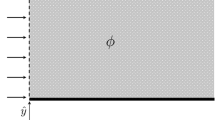Abstract
Several theoretical [1–4] and experimental [5–7] studies have been devoted to the study of the effect of distributed injection of a gaseous substance on the characteristics of the turbulent boundary layer. The primary study has been made of flow past a flat plate with gas injection. The theoretical methods are based primarily on the semiempirical theories of Prandtl [1] and Karman [2].
In contrast with the previous studies, the present paper proposes a power law for the mixing length; this makes it possible to obtain velocity profiles which degenerate to the known power profiles [8] in the case of flow without blowing and heat transfer. This approach yields analytic results for flows with moderate pressure gradient.
Similar content being viewed by others
Abbreviations
- x, y:
-
coordinates
- U, V:
-
velocity components
- ρ:
-
density
- T:
-
temperature
- h:
-
enthalpy
- H:
-
total enthalpy
- c:
-
mass concentration
- μ, λ, D:
-
coefficients of molecular viscosity, thermal conductivity, diffusion
- cp :
-
specific heat
- γ:
-
adiabatic exponent
- r:
-
distance from axis of symmetry to surface
- δ:
-
boundary layer thickness
- U∞ :
-
velocity in stream core
- τ:
-
friction
- cf :
-
friction coefficient
- P:
-
Prandtl number
- S:
-
Schmidt number
- St :
-
Stanton number
- M:
-
Mach number
- j=0:
-
plane case
- j=1:
-
axisymmetric case
- 1:
-
injected gas
- 2:
-
mainstream gas
- w:
-
quantities at the wall
- ∞:
-
core of boundary layer
- 0:
-
flow of incompressible gas without injection
- v=0:
-
flow of compressible gas without injection
- * :
-
quantities at the edge of the laminar sublayer
- ∘:
-
quantities at the initial section
- ε:
-
turbulent transport coefficients
References
W. H. Dorrance and F. J. Dore, “The effect of mass transfer on the compressible turbulent boundarylayer skin friction and heat transfer,” JAS, 21, no. 6, 1954.
Yu. V. Lapin, “Mass and heat transfer for turbulent flow of a compressible gas and injection of a foreign substance,” Zh. tekhn. fiz.,31, no. 11, 1961.
S. S. Kutateladze and A. I. Leont'ev, “Turbulent boundary layer on a porous wall,” PMTF, no. 1, 1962.
V. P. Motulevich, “Turbulent heat and mass transfer on a plate with porous suction and injection of various gases,” Inzh.-fiz. zh., no. 1, 1963.
C. C. Pappas and A. F. Okuno, “Measurements of skin friction of the compressible turbulent boundary layer on a cone with foreign gas injection,” JAS,27, no. 5, 1960.
H. Mickley, R. Ross, A. Squiers, and W. Stewart, “Heat, mass, and momentum transfer for flow over a flat plate with blowing or suction,” NACA TN 3208, July, 1954.
B. M. Leadon and C. J. Scott, “Transpiration cooling experiments in a turbulent boundary layer at M=3,” JAS,23, no. 8, 1956.
H. Schlichting, Boundary Layer Theory [Russian translation], Izd. inostr. lit., 1956.
L. Crocco, “An approximate theory of porous, sweat, or film cooling with reactive fluids,” J. Amer. Rocket Soc.,22, no. 6, 1952.
Author information
Authors and Affiliations
Rights and permissions
About this article
Cite this article
Sovershennyi, V.D. Turbulent boundary layer on a permeable surface. Fluid Dyn 1, 29–32 (1966). https://doi.org/10.1007/BF01106867
Issue Date:
DOI: https://doi.org/10.1007/BF01106867




